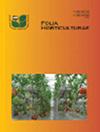赤霉素酸和6-苄基腺嘌呤可缩短牡丹的开花时间,提高花色品质
IF 1.8
4区 农林科学
Q2 HORTICULTURE
引用次数: 2
摘要
摘要植物生长调节剂(pgr)在具有重要经济价值的兰花杂交品种开花中的作用已经得到证实,但对具有商业潜力的野生品种的影响研究却很少。研究了赤霉素酸(GA3)和6-苄基腺嘌呤(BA)单独或联合施用3种剂量,以及不施用pgr的对照在3个花期的效果。在开花的时间行为,形态-花的质量参数和潜在的残留效应和畸形。在不同的试验时期和剂量之间观察到显著的影响,在第一个时期单次施用pgr减少了可见花诱导(DVFI)、开花(DAN)和花寿命(DFL)的天数,主要在第一个时期。不同剂量间各时期形态花质量参数差异不显著,但不同时期存在差异,第一时期花的寿命和大小显著增加,第二时期花和花茎数量显著增加。2.37 mg·L−1 BA + 100 mg·L−1 GA3在降低DVFI、DAN、增加DFL和花茎方面的一致性最高。在第二阶段的时间变量中观察到正的残余效应。所使用的大多数剂量对开花的各个方面都有有益的影响。本文章由计算机程序翻译,如有差异,请以英文原文为准。
Gibberellic acid and 6-benzyladenine reduce time to flowering and improve flower quality of Laelia anceps
Abstract The efficacy of plant growth regulators (PGRs) has been demonstrated in the flowering of economically significant orchid hybrids, but studies of their effects in wild species with commercial potential are scarce. The effect of three doses of gibberellic acid (GA3) and 6-benzyladenine (BA), individually or in combination, and a control without PGRs, were evaluated during three flowering periods in Laelia anceps subsp. anceps, in the temporal behavior of flowering, morpho-floral quality parameters and in potential residual effects and malformations. Significant effects were observed between the experimental periods and doses used, with a single application of PGRs in the first period reducing the days to visible flower induction (DVFI), days to anthesis (DAN) and days of flower life (DFL), mainly in the first period. There were no significant differences between doses for morpho-floral quality parameters within each period, but differences existed between experimental periods, where the life and size of the flower increased in the first period, and the number of flowers and flower stems increased significantly in the second period. The doses of 2.37 mg · L−1 BA + 100 mg · L−1 GA3 showed highest significant consistency in the reduction of DVFI, DAN and increase of DFL and flower stems in the study. There were no floral malformations, and a positive residual effect was observed in temporal variables in the second period. Most of the doses used encourage beneficial effects in the various aspects of flowering evaluated.
求助全文
通过发布文献求助,成功后即可免费获取论文全文。
去求助
来源期刊

Folia Horticulturae
Agricultural and Biological Sciences-Horticulture
CiteScore
3.40
自引率
0.00%
发文量
13
审稿时长
16 weeks
期刊介绍:
Folia Horticulturae is an international, scientific journal published in English. It covers a broad research spectrum of aspects related to horticultural science that are of interest to a wide scientific community and have an impact on progress in both basic and applied research carried out with the use of horticultural crops and their products. The journal’s aim is to disseminate recent findings and serve as a forum for presenting views as well as for discussing important problems and prospects of modern horticulture, particularly in relation to sustainable production of high yield and quality of horticultural products, including their impact on human health.
 求助内容:
求助内容: 应助结果提醒方式:
应助结果提醒方式:


